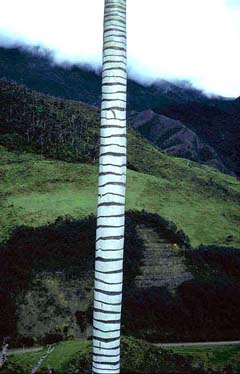Ceroxylon ventricosum Informationen
A solitary, tall, water-loving, slow growing, dioecious, forest emergent palm. Rare in cultivation, rare in the wild. It has a smooth, whitish waxy trunk, 30.5 m. (100 ft.) tall, 60 cm. (24 inch) diameter with spaced ring leaf scars, and huge segmented, pinnate (feather) leaves, 5 m. (16 ft.) long, 1.2 m. (4 ft.) wide, dark green above and, whitish beneath.
Occurs naturally in the wet Andes of South America to 3000 m. (10,000 feet) altitude. Trunks are usually slightly swollen or bulging near their middles, are white, and bear beautiful undulating dark ring leaf scars.
Ceroxylon ventricosum can tolerate freezing temperatures to about -3.8°C (25°F). It naturally occurs in open woodland or grassland in sun exposed, montane locations, and should be planted to maximise sunshine exposure. Under extreme freezing conditions we recommend you keep this palm as dry as possible. It should be noted that in its natural habitat the temperature swings between extreme heat and extreme cold occur within 12 hours (night & day) of a single day, and have little to do with Summer/Winter seasons. Therefore, this palm dislikes long durations of cold weather and may require additional heat or protection during the coldest weather.
Identification:
Canopy palm. Stem solitary, ventricose, 6-25(-35) m tall and 20-44(-60) cm in diameter in the middle, white, with conspicuous dark leaf scars, turning green towards apex, covered with thick layer of wax. Leaves 16-20, in a dense, hemispheric crown; sheath 100-150 cm long, abaxially covered with thick layer of persistent yellowish or brownish, degraded scales; petiole 30-59 cm long, 6-10 cm wide at the apex; rachis 250-334 cm long, twisted 90° on distal portion thereby holding the pinnae in a vertical position, adaxially flattened in one third of its length, hastula-like projection 1 mm long, glabrescent, abaxial surface covered with appressed, white, translucent scales that are often degraded; pinnae 118-151 on each side, arranged toward the middle of the leaf in groups of 2-4(-7), very close to each other, oriented in slightly divergent planes, but basal and apical pinnae regularly arranged or tending to a disposition at regular intervals, the terminal half of each pinnae pendulous, abaxial surface covered with long, yellowish scales; Inflorescences erect, to 350 cm long, branched 3 times. Fruits globose, orange-red when ripe, 1.5-1.8 cm diam., exocarp smooth; Seeds ca. 1.3 cm diam. C. ventricosum is characterized by its massive, robust and white stem, by its leaves twisted 90° on distal portion thereby holding the pinnae in a vertical position, the pinnae pendulous and arranged in hardly discernible groups toward the middle of the leaves, staminate flowers with 9-11 stamens and smooth fruits. The best way to distiguish it from C. quindiuense is in its grouped pinnae spreading in various planes, whereas, C. quindiuense has regularly arranged, pendulous (in one plane) pinnae.
Allgemeine Informationen:
According to the IUCN criteria, considered Vulnerable (VU) in Ecuador and endangered (EN) in Colombia, because of habitat reduction and the small size of the populations. Well worth trying in the UK with it's moist, mild winters.
Verteilung:
Heimisch in, Colombia, Ecuador
Grows from the South of Colombia (Central Cordilllera, western slope in Cauca and Eastern slopes of the Andes in Putumayo) to the south-east of Ecuador, in moist montane forest or kept on pastures, at (1800-)2000-3000 m, usually above 2500 m. It is commonly found forming stands of hundreds of individuals. It is also cultivated as ornamental in Ecuador.
Ort: Ecuador, Colombia (-1.239893°N, -78.332520°E)
Beobachtungen
Ceroxylon ventricosum Overlay-Bild ©2025 Trebrown - Nein unerlaubte Umverteilung.

